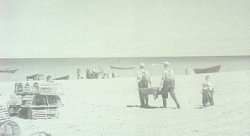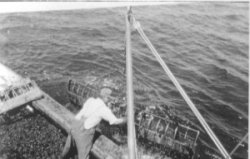
|
Fishing in Tignish
Boats & Gear
The many advancements in sea-faring vessels have allowed fishers to travel farther from land
and stay out for longer periods of time. Early on, fishers used dories which either had to be
rowed, or they used sails to get around. Today, the most common boat used is the Cape Islander named
after Cape Sable Island, Nova Scotia, where the late H.A. Atkinson is generally believed to have
built the first such craft. The name, Cape Islander, may not be well known because these boats
usually have local names.
 Early days of lobster fishing - dories launched from the beach The Cape Islander is generally used because it is easy to maintain, relatively fast - powered by either marine diesel or gas engines, and has a cabin which shelters fishers from the elements. Electronic equipment has allowed for safer and more efficient fishing. In addition to such conveniences as CB (Citizen's Band) radios, which enable fishers to communicate with each other and the shore, fishers now have electronic navigational aids, depth-sounders and "fish-finders". Today, much of the manual labour has been eliminated by the use of winches that haul nets or traps the majority of the distance. The fishers then haul the nets or traps into the boat by hand.
Fish Though in the early days many fish were taken out of the waters of Tignish, including Nothern Cod, Herring and Mackerel, today there is very little fishing of Groundfish or Pelagic fish, except for the use of bait in lobster traps. Currently, many types of fish, like Cod, Flounder, Hake, Shark, Dogfish, Herring and Mackerel, are caught by fishers, but since there is not always a consistent demand for these fish, fishers do not depend on them as a main source of their income. Irish Moss Perhaps the best-known and most valuable of all the "seaweeds" is Irish Moss
(Chondrus crispus). It contains a substance called carrageenan which is extracted by boiling the
moss. The carrageenan resembles starch, but is colourless, odourless, tasteless and contains
no calories. Carrageenan is useful to the Food and Pharmaceuticals Industry for its properties in emulsifying, gelling
and stabilizing products without changing their colour, smell or taste.
Lobsters Lobsters can easily be classified as the cornerstone of the Tignish fishing industry. While there has been a variety of fish taken from our waters, the most consistent section of the fishing industry has been lobsters, due to their abundance. While there have been many rules and restrictions added to regulate the fishing of lobsters, catches have remained healthy over the years. Like the fishing industry itself, there has been no increase in the number of lobsters to be caught. The introduction of better boats, engines and new technology has allowed lobsters to be caught more "efficiently".
One notable aspect of the lobster industry is its improvment in the area of lobster processing.
Lobsters can now be cooked, frozen, and packaged much more quickly than they were in earlier
times. The canning process revolutionized lobster fishing because lobsters could not be dried,
salted or pickled. Until that time, they had little economic value around the shores of Prince
Edward Island.
|





